Articles
- Page Path
- HOME > J Korean Acad Nurs > Volume 38(1); 2008 > Article
-
Original Article
- Types of Attitudes toward a Successful Life of Korean Nursing Students: A Q-Methodological Approach
- Kae-Hwa Jo
-
Journal of Korean Academy of Nursing 2008;38(1):111-121.
DOI: https://doi.org/10.4040/jkan.2008.38.1.111
Published online: February 28, 2008
Associate Professor, Department of Nursing, Catholic University of Daegu, Daegu, Korea.
- Address reprint requests to: Jo, Kae Hwa. Department of Nursing, Catholic University of Daegu, 3056-6 Daemyung 4-dong, Nam-gu, Daegu 705-718, Korea. Tel: 82-53-650-4825, Fax: 82-53-621-4106, jokw@cu.ac.kr
Copyright © 2008 Korean Society of Nursing Science
- 580 Views
- 1 Download
- 2 Crossref
Abstract
-
Purpose
- The purpose of this study was to analyze attitudes toward a successful life of students majoring in nursing science.
-
Methods
- The Q-methodology which provides a method of analyzing the subjectivity of each items was used. The 32 selected Q-statements from each of 36 subjects were classified into a shape of normal distribution using a 9 point scale. The collected data was analyzed using a QUANL PC program.
-
Results
- Four types of successful life attitudes for research subjects in nursing science were identified. Type I is purpose achievement type, Type II is calling fullness type, Type III is balance maintenance type, and Type IV is happiness eagerness type.
-
Conclusion
- The results of the study indicate that different approaches to nursing professional education programs are recommended based on the four types of successful life attitudes.
- 1. Cha DK, Kim KH. Professional ethics and personality of the Koreans. 2000;Daegu, Junglimsa.
- 2. Fromm E. To have or to be. 1976;New York, Harper & Row.
- 3. Han JS. The university student's fear of success and its variables. J Asian Women. 1988;27:77–102.
- 4. Hwang SM. An estimation of generation and future society's personality through life cycle. Phenomenon and cognition. 1999;winter:100–118.
- 5. Jun HY, Yim HB. A study on the image of nursing in the nursing students. Bulletin Dongnam Heal College. 2001;19(2):71–77.
- 6. Jung CG. Psychological types. 1971;New Jersey, Primceton University Press.
- 7. Jung CK. The effect of self-concept, ego-identity, and internalexternal control on career decision making. 1991;Seoul, Kunkuk University. Unpublished doctoral dissertation.
- 8. Kim HG. Understanding of Q-methodology for the study of subjectivity. Seoul Univ Nur Inq. 1992;6(1):1–10.
- 9. Kim UC, Park YS. Stress experience, result of coping and adoptation: indigenous psycho-analitical approach. Korean J Health Psychol. 1997;2(1):96–126.
- 10. Kim UC, Park YS, Kim ME, Lee GU, Yu HS. Intergenerational differences and life satisfaction: comparative analysis of adolescents, adults, and the elderly. Korean J Health Psychol. 2000;5(1):119–145.
- 11. Kishor N. Locus of control and academic achievement: ethnic discrepancies among Fijians. J Cross Cult Psychol. 1983;14:299–308.
- 12. Koh HJ. A study on the effect of carceer counseling on Korean college students' decision making styles and on career decision making status. 1992;Seoul, Sookmyung Women's University. Unpublished doctoral dissertation.
- 13. Koh IH. Life and professional view. Collection of Articles Humanities and Art. 2002;23:1–9.
- 14. Korean language dictionary compilation committee. Korean language dictionary. 2006;Seoul, Samsungmoonwhasa.
- 15. Lee HR, Choi KO, Koh JE, Hong MR, Kim SY, Shin HS. The study on nurses' image. J Kyunghee Nurs. 1992;15:45–65.
- 16. Lim YJ. A study on effects of sex-role related factors on career choices of female college students. 1994;Seoul, Hongik University. Unpublished doctoral dissertation.
- 17. Park YS. Indigenous analysis of achievement and attributional style: a Korean perspective. Korean J Psychol Soc Issues. 2000;6(3):67–98.
- 18. Park YS, Kim U. The educational challenge of Korea in the global era: the role of family, school, and government. Education Journal. 1999;27(1):91–120.
- 19. Park YS, Kim UC, Tac SY. Failure experience and aspirations for the future: Indigenous psychological analysis of Korean adolescents and their parents. Korean J Psychol Soc Issues. 2005;11(2):73–108.
- 20. Patterson CH. Theories of counseling psychotherapy. 1980;New York, Harper & Row.
- 8. Rogers CR. On becoming a person: A therapist's view of psychotherapy. 1961;Boston, Houghton Mifflin.
- 22. Stephenson W. Q-Methodology, interbehavioral psychology and quantum theory. Psychol Rec. 1982;3:238–248.
- 23. Yu AB, Yang KS. Kim U, Triandis HC, Kagitcibasi C, Choi SC, Yoon G. The nature of achievement motivation incollectivistic societies. In: Individualism and collectivism: Theory, method, and applications. 1994;Thousand Oaks, CA, Sage. 239–250.
REFERENCES
Figure & Data
REFERENCES
Citations

- Relationship between Gender Roles and Job Satisfaction among Neurological Physical Therapists
Ji-Whan Park, Seul-Ki Han, Dae-Hee Lee
Journal of The Korean Society of Physical Medicine.2016; 11(3): 81. CrossRef - Effect of gender role identity on choice of dental hygiene and professionalism
Seon-Yeong Kim, Yun-Jeng Kim, Sang Eun Moon
Journal of Korean society of Dental Hygiene.2015; 15(2): 295. CrossRef
Distribution of Q-sample Card
Eigen values, Variance, and Cumulative Percentage
Types, Weights, Demographic Characteristics for P-samples
VAR=Variable; C.N=Clinical nurse; N.R=Nursig researcher; I.N=Industrial nurse; B & S=Brothers and sisters; N.P=Nurse practitioner; H.T=Health teacher.
Q-samples and Z-scores according to Types
Descending Array of Z-scores (greater than±1) and Item Descriptions for Type 1 (N=12)
Descending Array of Z-scores (greater than±1) and Item Descriptions for Type 2 (N=9)
Descending Array of Z-scores (greater than±1) and Item Descriptions for Type 3 (N=4)
Descending Array of Z-scores (greater than±1) and Item Descriptions for Type 4 (N=10)
VAR=Variable; C.N=Clinical nurse; N.R=Nursig researcher; I.N=Industrial nurse; B & S=Brothers and sisters; N.P=Nurse practitioner; H.T=Health teacher.
 KSNS
KSNS
 E-SUBMISSION
E-SUBMISSION


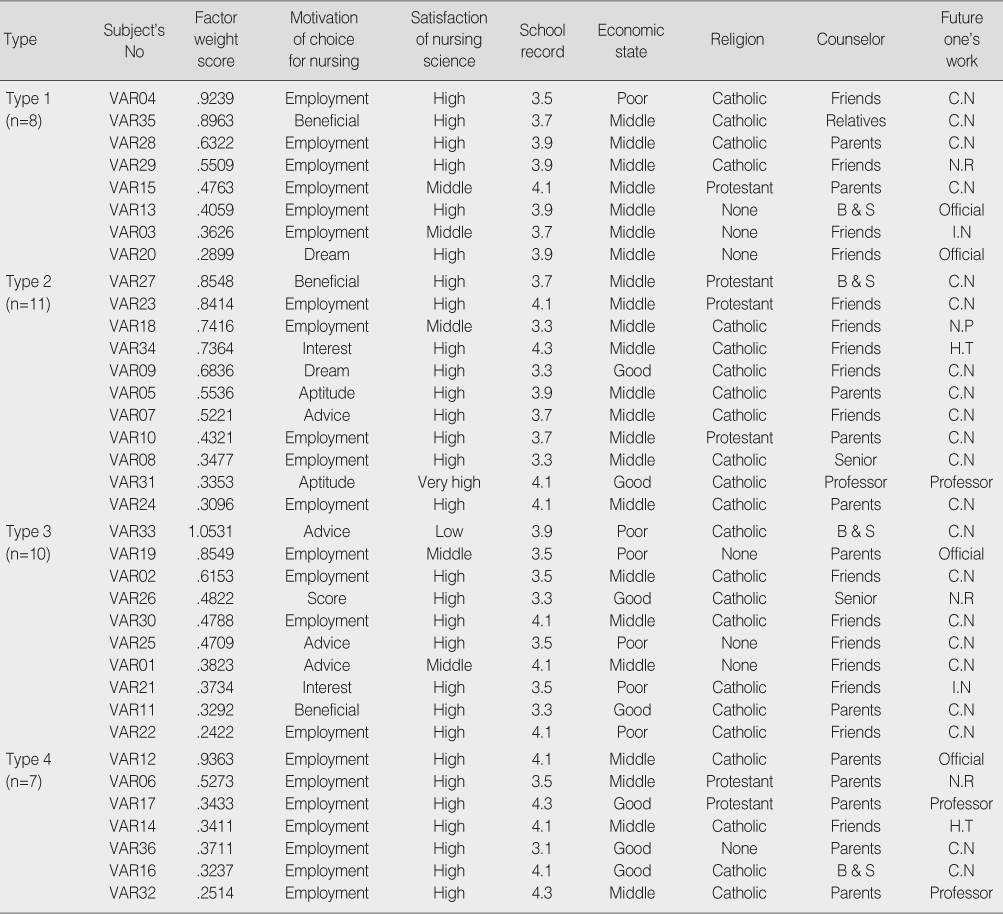
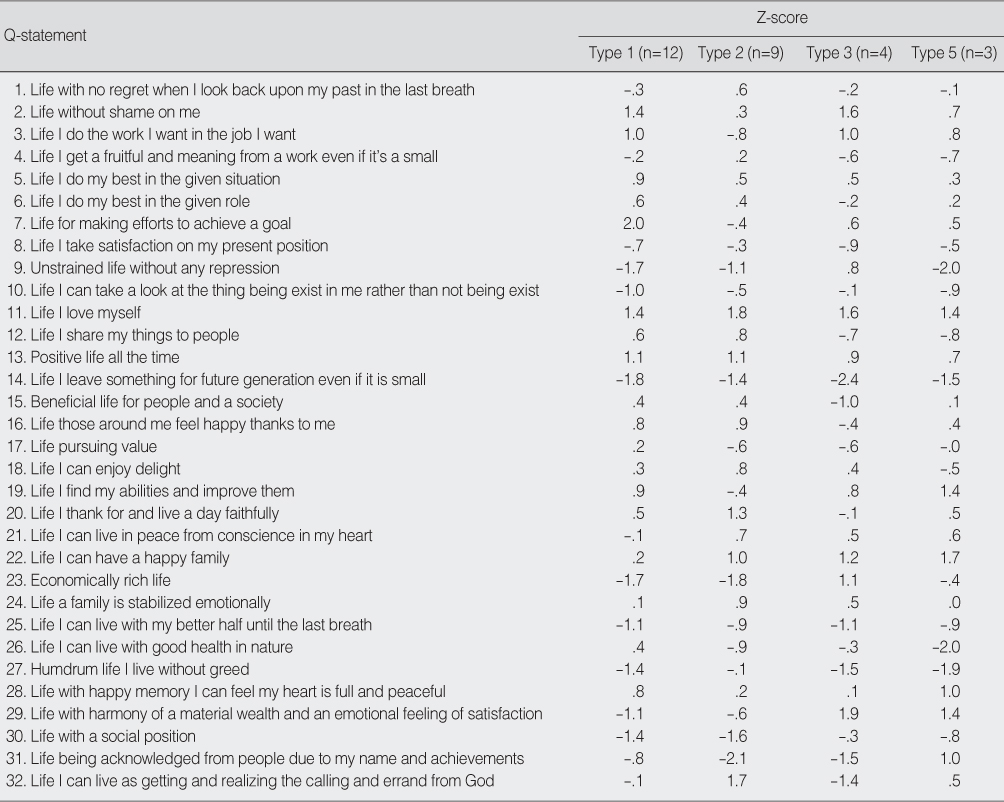
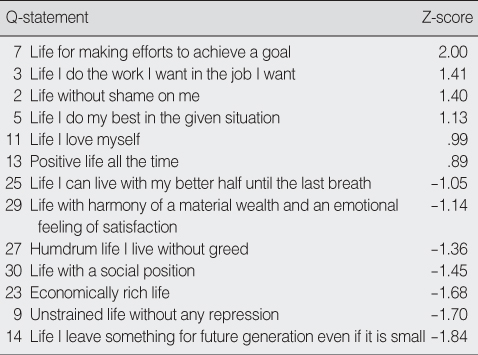
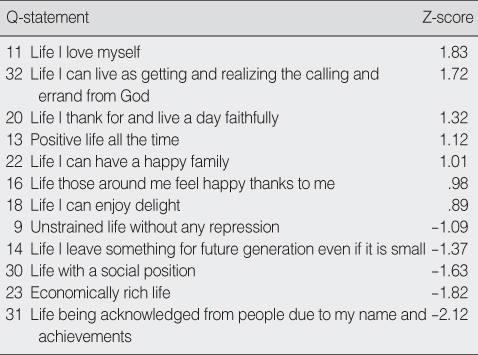
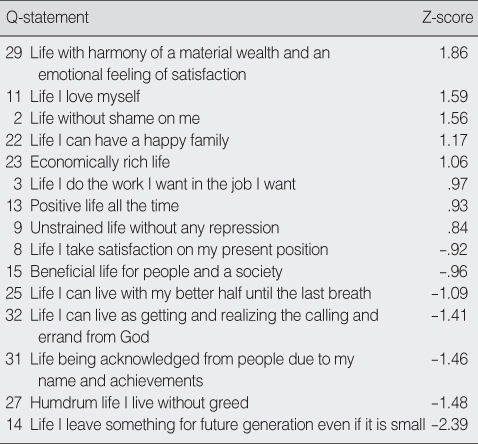
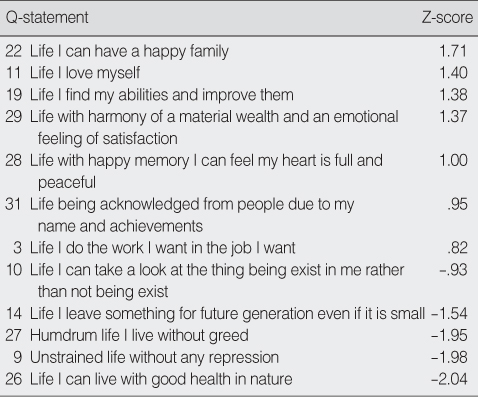
 Cite
Cite

